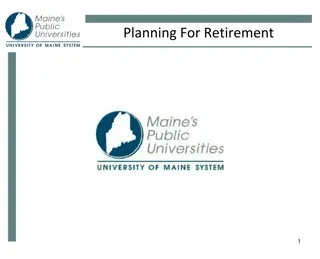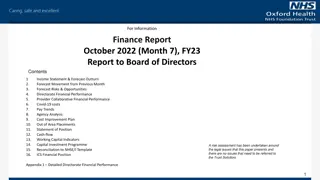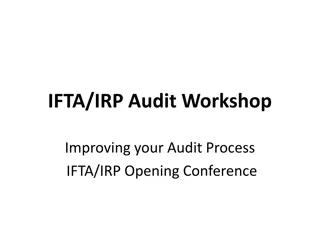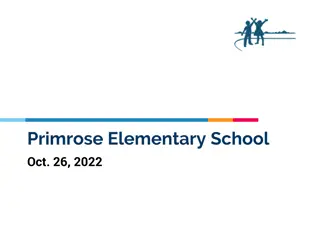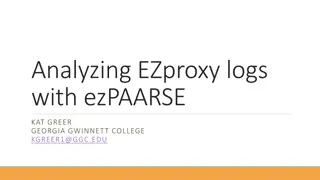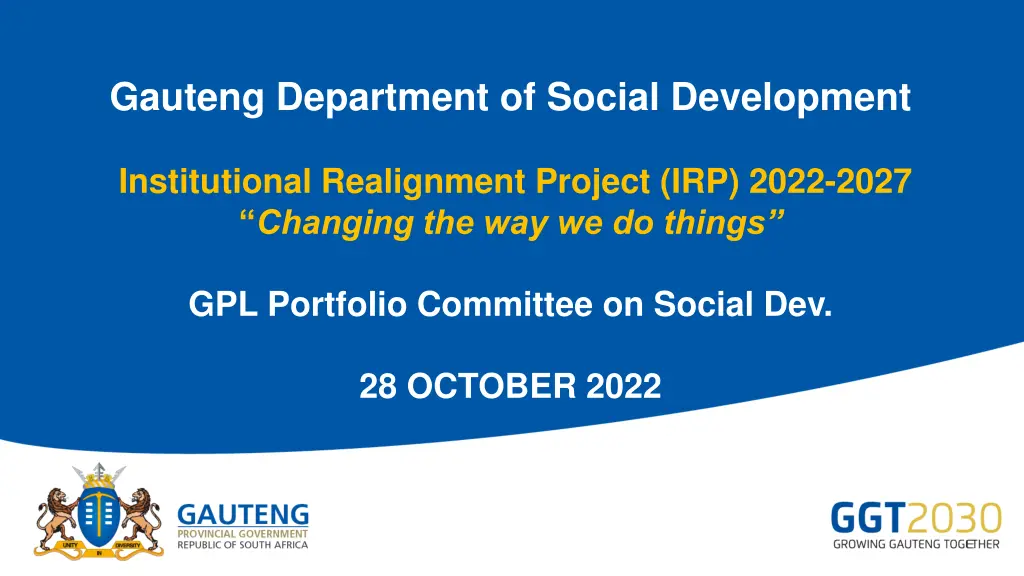
Gauteng Department of Social Development Institutional Realignment Project Summary
Explore the Gauteng Department of Social Development's Institutional Realignment Project (IRP) for 2022-2027. Learn about key legislative frameworks, budget distribution, proposals for state capacity strengthening, and implications on the NPO sector. Discover the value of the IRP to DSD and the NPOs. Stay informed on the project's purpose, implementation plan, and strategic importance in transforming social development services in Gauteng.
Download Presentation

Please find below an Image/Link to download the presentation.
The content on the website is provided AS IS for your information and personal use only. It may not be sold, licensed, or shared on other websites without obtaining consent from the author. If you encounter any issues during the download, it is possible that the publisher has removed the file from their server.
You are allowed to download the files provided on this website for personal or commercial use, subject to the condition that they are used lawfully. All files are the property of their respective owners.
The content on the website is provided AS IS for your information and personal use only. It may not be sold, licensed, or shared on other websites without obtaining consent from the author.
E N D
Presentation Transcript
Gauteng Department of Social Development Institutional Realignment Project (IRP) 2022-2027 Changing the way we do things GPL Portfolio Committee on Social Dev. 28 OCTOBER 2022
Presentation Outline Purpose Introduction Key legislative and policy frameworks IRP in a nutshell Budget distribution Govt vs NPOs Proposals towards strengthening state capacity Institutional arrangements Workstreams Project implementation plan Value of the IRP to DSD Implications of IRP to the NPO Sector
Purpose To provide an overview of the Institutional Realignment Project (IRP) To inform the Portfolio Committee on the IRP and its implications to the Department and the NPO sector
Introduction GDSD is mandated by various legislative and policy prescripts to render core services through a variety of programmes that enables target groups to deal effectively with all social ills and other adverse social conditions GDSD currently employs the bulk of social service professionals to effectively deal with the social problems and issues such as psychological stress, chronic poverty, food insecurity and other adverse social conditions. GDSD faced lack of capacity to implement these policies and programmes due to amongst others, the overwhelming demand for services and the inability of the sector to deal effectively with the surge in demand, mainly because of the shortage of Social Workers. To mitigate this, the GDSD implemented the Recruitment and Retention strategy for Social Workers whilst simultaneously increasing the number of funded NPOs This led to increased internal capacity to provide services by appointing additional social service professionals such as Social Workers, Social Auxiliary Workers and Child and Youth Care Workers to implement services to the vulnerable groups
Key Legislative and Policy Frameworks Constitution of the Republic of South Africa, Act 108 of 1996 Children s Act, 38 of 2005: The Children s Second Amendment Act 18 (c) of 2016 Older Persons Act,13 of 2006 Prevention of and Treatment for Substance Abuse Act 70 of 2008: Child Justice Act, 75 of 2008: The Prevention and Combating of Trafficking in Persons Act, 7 of 2013 The Probation Service Act, 116 of 1991 The Criminal Procedures Act, 51 of 1971 White Paper on the Rights of Persons with Disabilities, 2015 The White Paper on Families, 2013. The National Strategic Plan for HIV, TB and STIs, 2017-2022 National Strategic Plan for Gender Based Violence and Femicide National Development Plan (2030) The White Paper for Social Welfare (1997)
IRP in a nutshell What is IRP Project undertaken by the department to build the state capacity and reduce over reliance on NPOs on the constitutionally legislated mandates The project is informed by the approved Service Delivery Model and the Organizational Re- alignment (new Organogram for GDSD) which must be funded mainly from within the Department DSD must be the leader of the social development sector, which is an area that straddles other Government spheres and those of civil society and should be able to develop technical and specialist professional skills as envisaged by the National Development Plan(NDP,2030). The Department has a commensurate responsibility to have sufficient human resources to enable delivery on this mandate. This includes capability in workforce planning and development to ensure that there is a pool of talent to enable the Department to realise its legislated mandate
IRP in a nutshell Cont.. Why IRP The Department is & should be in the forefront of dealing with these challenges through the implementation of variety programmes designed to care, support, protect and empower the most vulnerable in our communities. Due to the shrinking budget, government departments are expected to do more with less due to declining revenue. This is happening at the same time as the shrinking donor funding for NPOs. The current partnership model with NPOs is unsustainable as more resources are allocated to NPOs at the expense of a developed state capacity. Service delivery by NPOs still remains largely at urbanized areas Delivery of services often does not reach those who need them the most Factors that contribute to failures in service delivery include lack of governance and leadership, institutional inadequacies GDSD has appointed hundreds of new social workers into the system over the past years. The increase in internal capacity must translate directly into increased state capacity
IRP in a nutshell Cont.. GDSD implemented retrieval of services previously in areas where internal capacity has been built and to protection of vulnerable groups including children: In 2012/2013 FY, GDSD retrieved probation services from NPOs. These include assessment of children in conflict with the law, presentence reports, pre-trial reports, victim impact statements etc. In December 2021, the department successfully retrieved secure care services for children in conflict with the law from Mogale CYCC (Former Bosasa). Qualifying staff from Mogale Secure Care were absorbed into GDSD workforce. The GDSD has been retrieving services from non-performing/non compliant Child Protection Organizations (CPOs) and other services, Kagiso Child Welfare, NG Welsyn, WAWA Toekomsus, RIET, CMR North etc. As of June 2021, GDSD trained & registered 159 social workers to do adoption services free of charge All these services are now provided by the department
Budget distribution Govt vs NPOs The size and scope of NPO sector has grown significantly since the 1990s. According to the recent data from NDSD, there are 258 827 registered NPOs and 148 306 of these are non-compliant. Gauteng has 81 996 registered NPOs and 47 677 are non-compliant. Of the registered NPOs, 27 117 are registered to provide social welfare services in Gauteng. The Department of Social Development in Gauteng funded approximately 3 402 during the 2021/2022 FY. FINANCIAL YEAR 2016/2017 DSD BUDGET TRANSFERS TO NPOS R2,249,623 % TO NPOS R4,271,602 53% 2017/2018 R4,586,319 R2,452,366 53% 2018/2019 R4,661,496 R1,935,907 42% 2019/2020 R5,442,951 R2,277,987 43% 2020/2021 R5,887,349 R2,571,152 41% 2021/2022 R6,148,557 R2,783,547 44% 2022/2023 R5,537,037 R2,240,870 40%
National Budget Distribution: State viz NPOs Source: Team analysis - 06
Budget distribution cont. Already in 2016/17, GP allocated 48.6 % of its expenditure on social welfare services to NPOs, while WC transferred 47.4 % At the other end, KZN transferred 27.6 % of its spending on social welfare services, NC allocated only 16.2 %, with NW at 17.6 per cent and EC at 17.8 % of its expenditure on social welfare to NPOs Despite the NAWONGO Judgements, the FS reduced its funding for NPOs from R162 m in 2013/14 to R154 m in 2014/15, and to R151 m in 2015/16.
Proposals towards strengthening state capacity Re-organise the state-civil society model for delivering welfare services to ensure greater accountability and improve service delivery In SWS, the state has adopted a partnership model of service provision and relies mainly on NGO s to provide professional social services. Funding of these organisations has declined steadily since 1994, reducing the range & compromising the quality of services at the same time as demand for such services has increased. Such organisations are unable to respond to the scale & complexities of SA's poverty, social fragmentation & lack of social support systems. Increasingly, the burden of care has fallen on the poorest communities & on women & the elderly, often leading to a sense of powerlessness & social isolation. There is also a need to ensure that accountability is built into partnerships with the non-governmental sector. The state has to ensure that nongovernmental providers do not take advantage of vulnerable groups and that they provide the correct benefits.
Proposals towards strengthening state capacity Address the skills deficit in the social welfare sector In the immediate and medium term, the country needs to increase the supply of 4 categories of social service professionals to respond to the demand for appropriate basic social welfare services (Social Workers, SAWs, CDPs & CYCWs). Responding to the social breakdown of families, communities and society requires a range of generic and specialist education and training that is not available to poor communities. Problems in the supply of qualified social service professionals are also linked to poor working conditions and a lack of funding for social services. The skills deficits are not limited to the social welfare sector. Delivery of effective and efficient social protection services is reliant on an effective and capable public sector.
Proposals towards strengthening state capacity The state should play a much larger role in the provision of social welfare services, including establishing effective partnerships with the private and community sectors SA needs to confront the reality that social services are critical for improving social integration and human development. The current model of shifting the burden of care, treatment & rehabilitation to the NGO sector & the poorest communities need to be reviewed. Complex social problems require professional interventions to deal with the symptoms and underlying causes of social pressures, most evident in schools, workplaces and neighbourhoods that are plagued by gang warfare and households afflicted by violence, including the abuse of women and children.
Institutional Arrangements Approved Framework Project Implementation Plan Project Steering Committee
Workstreams Partnerships and Finance Regions and Institutions Programmes HR Infrastructure Communications Stakeholder Relations Risk Management
Key elements of project implementation plan Implementation plan covers the following aspects: Analysis of internal capacity Supervision Mapping of services Skills Audit Assessment of workloads Training and capacity building Analysis of available resources Review of funding processes and priorities Review of APP targets Monitoring and evaluation Addressing Infrastructure and related challenges Stakeholder Management and Communications Management of project risks
Value of the project to GDSD Reduced overreliance on NPOs to implement constitutionally legislated mandates Improved and better integrated planning within the department: Reproduction of skills and foster sense of professional common purpose for SSPs Capacitated, empowered an accessible public service responding to the needs of vulnerable groups Enhanced systems, structures and mechanisms of coordination at all levels to promote professional, ethical, and efficient service delivery Strengthen and sustain the capacity of the department to enhance accountable and transparent public service through effective monitoring, evaluation, and verification processes. Strengthening of monitoring, QA, QI, quality controls across all levels Capability matching and production of specialist technical skills that are necessary to fulfill core functions and mandates of the department Maximised utilisation of existing resources Communities will be aware of service provision by the department
Implications of IRP to the NPO Sector Retrieval of functions from identified non-performing/dysfunctional NPOs (non-centre based services, non-compliant NPOs or NPOs suspended from service) Take over of identified services including certain statutory services (e.g. new foster care cases, adoption services, etc.) Retrieval of services will not be considered for residential facilities (at least for now) due to limited capacity. These incl CYCC, Shelters for Homeless, Shelters for victims of GBV, Residential Facilities for Older Persons, Residential Facilities for Persons with Disabilities, Inpatient Treatment Centres & Halfway Houses Moratorium on new applications for funding of residential facilities or additional funding of beds at existing facilities and new NPOs except in identified priority areas Advertisements for 2023/2024 financial year will be informed by departmental needs and priorities APP and operational plans targets for govt and NPOs to be reviewed. Improved programme and finance monitoring Reduction in the number of funded NPOs
Recommendations It is recommended that the Portfolio Committee: Note the presentation on the Institutional Re-alignment Project (IRP) 2022-2027






